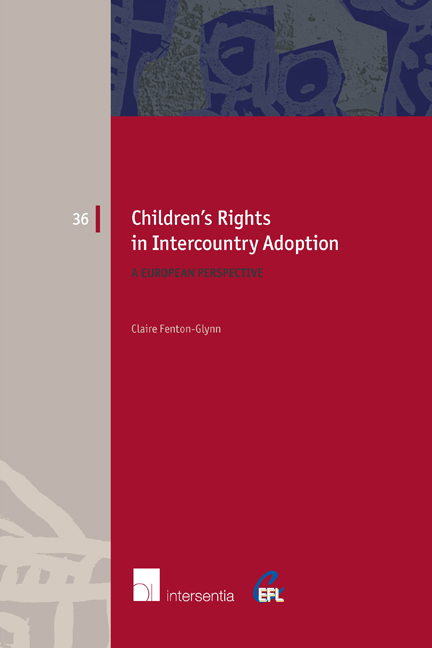Book contents
- Frontmatter
- Dedication
- Acknowledgements
- Contents
- Table of Cases
- Chapter 1 Introduction
- Chapter 2 Combating Abuses: International and Regional Regulation
- Chapter 3 Intercountry Adoption and the Domestic Child Welfare System: The Principle of Subsidiarity
- Chapter 4 Consenting Adults: Giving and Receiving Consent to Adoption
- Chapter 5 Buying Babies: The Inducement of Consent
- Chapter 6 Compulsory Adoption: Adoption Without Consent
- Chapter 7 Child Participation: Autonomy and Protection
- Chapter 8 Adoptive Parents: Eligibility, Preparation, and Support
- Chapter 9 Who Am I? The Child's Right to Identity
- Chapter 10 Conclusion
- List of Legislation
- Literature
- Index
- About the Author
- Miscellaneous Endmatter
Chapter 1 - Introduction
Published online by Cambridge University Press: 26 November 2017
- Frontmatter
- Dedication
- Acknowledgements
- Contents
- Table of Cases
- Chapter 1 Introduction
- Chapter 2 Combating Abuses: International and Regional Regulation
- Chapter 3 Intercountry Adoption and the Domestic Child Welfare System: The Principle of Subsidiarity
- Chapter 4 Consenting Adults: Giving and Receiving Consent to Adoption
- Chapter 5 Buying Babies: The Inducement of Consent
- Chapter 6 Compulsory Adoption: Adoption Without Consent
- Chapter 7 Child Participation: Autonomy and Protection
- Chapter 8 Adoptive Parents: Eligibility, Preparation, and Support
- Chapter 9 Who Am I? The Child's Right to Identity
- Chapter 10 Conclusion
- List of Legislation
- Literature
- Index
- About the Author
- Miscellaneous Endmatter
Summary
Intercountry adoption began as a humanitarian practice, first used to assist children orphaned by World War II and subsequently those in the aftermath of the conflicts in Korea and Vietnam. However, in the years since, it has evolved into a multi-million dollar business, marred by widespread accusations of human rights abuses, and concern over the law's ability to prevent them.
European jurisdictions play a central role in intercountry adoption, both as countries of origin for children being placed, and as receiving countries. In 2010, 50 per cent of all children involved in intercountry adoption worldwide were sent to countries within Europe, while three European states – France, Spain and Italy – have been in the top five receiving states in the world for the past 15 years. In addition, of the approximately 30,000 children involved in intercountry adoption per year worldwide, around one third come from European jurisdictions.
Europe is also very interdependent when it comes to intercountry adoption, with the majority of children from European states of origin being sent to receiving countries within Europe. While practice in receiving countries is more varied, as can be seen below, adoptions within the region still make up a significant proportion of the overall figures.
In this context, the question that this book aims to answer is very simple: how can we best protect the rights of children involved in intercountry adoption in Europe?
The book will neither encourage greater use of intercountry adoption as a placement for children, nor advocate for it to be curtailed. Instead, it recognises that intercountry adoption can provide a valuable placement option for certain children, provided that it is appropriately regulated. The question remains how this regulation can be achieved whilst ensuring that unnecessary bureaucracy does not de facto limit adoptions that should take place.
The international community has attempted to regulate the intercountry adoption system through the 1993 Hague Convention on Protection of Children and Co-operation in Respect of Intercountry Adoption (Hague Convention). While this Convention, which has 93 contracting states, has provided important procedural safeguards and effectively coordinated responsibilities between sending and receiving states, it defers extensively to domestic authorities in deciding how best to protect substantive rights.
- Type
- Chapter
- Information
- Children's Rights in Intercountry AdoptionA European Perspective, pp. 1 - 10Publisher: IntersentiaPrint publication year: 2014



